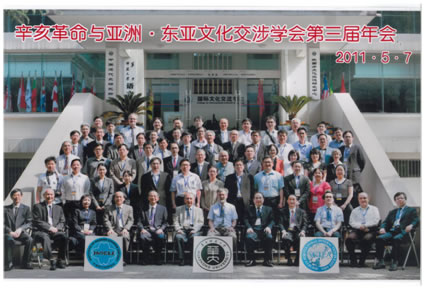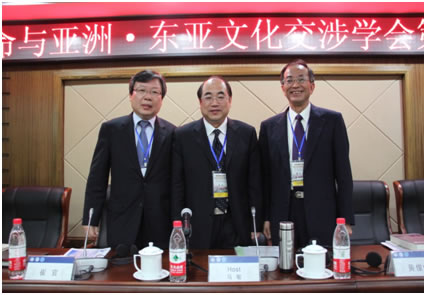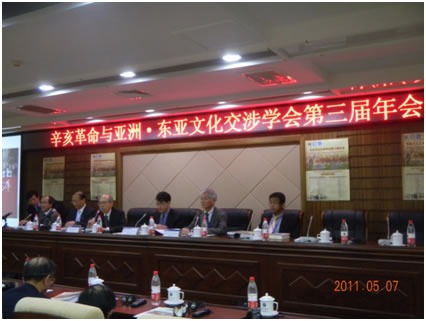Journal of Cultural Interaction in East Asia Vol.3 ―Table of Contents
Preface
| Address at the opening Session of the Third Annual Meeting at Huazhong Normal University on May 7, 2011 (MA Min) | 詳細 |
Articles
| The Regional Structure of the 1911 Revolution: The North and the South in Chinese History (MURATA Yūjirō) | 詳細 |
| The 1911 Revolution and the Korean Independence Movement: The Road to Democratic Republicanism (KIM Bong-jin) | 詳細 |
| Gained in Translation: Ezra Pound, Hu Shi, and Literary Revolution (Jenine HEATON) | 詳細 |
Opinion Forum
| Ideals and Reality: Sun Yat-sen’s Dream for Asia (ZHANG Kaiyuan) | 詳細 |
| Dr. Sun Yat-sen’s Pan-Asianism Revisited: Its Historical Context and Contemporary Relevance (HUANG Chun-chieh) | 詳細 |
| Huang Xing and Traditional Chinese Culture (XIAO Zhizhi) | 詳細 |
Research Trends
| Zhang Peiheng’s A New History of Chinese Literature and Its Japanese Translation (CHEN Zhenghong) | 詳細 |
| Manchu Studies in Korea (CHOE Yongchul) | 詳細 |
Book Reviews
| Ge Zhaoguang, Zhai zi Zhongguo: Chongjian youguan “Zhongguo” de lishi lunshu (Dwelling Here in China: Reconstructing the History of the Concept of China) by SUN Weiguo | 詳細 |
| Matsuura Akira, Kinsei Higashi Ajia kaiiki no bunka kōshō (Cultural Interactions in Maritime East Asia during Premodern Times) by WANG Zhenping | 詳細 |
| Uchida Keiichi, Bunka kōshō gaku to gengo sesshoku: Chūgoku gengogaku ni okeru shūen kara no apurōchi(Cultural Interaction Studies and Linguistic Contact: The Peripheral Approach in Chinese Linguistics)by SATO Haruhiko | 詳細 |
| Liu Yuebing, Riben jinxiandai sixiangshi(A History of Modern Japanese Thought)by WU Guanghui | 詳細 |
Introduction of Major Institutions
| The Institute of Oriental and Occidental Studies at Kansai University (關西大學東西學術研究所) |
詳細 |
| Institute of International Maritime Affairs at Korea Maritime University (韓國海洋大學校國際海洋問題研究所) |
詳細 |
| The Research Institute of Korean Studies at Korea University (高麗大学校韓國學研究所) |
詳細 |
| Research Center for Nonwritten Cultural Materials at Kanagawa University (神奈川大學非文字資料研究中心) |
詳細 |
| Japanese Research Institute at Nankai University (南開大學日本研究所) |
詳細 |
| The East Asian Cultural Research Team of the Research Center for International Japanese Studies at Hosei University (法政大学国际日本学研究所东亚文化研究课题组) |
詳細 |
Contribution Guidelines
| Contribution Guidelines | 詳細 |
Journal for Cultural Interaction in East Asia Vol.3

A commemorative photo after the opening session of the Third Annual Meeting in Wuhan, on May 7, 2011.

A commemorative photo of the change of president. From Left: Vice President Choi Gwan, President Ma Min, Ex-President Huang Chun –chie.
Preface: Address at the opening Session of the Third Annual Meeting at Huazhong Normal University on May 7, 2011
MA Min
The Regional Structure of the 1911 Revolution: The North and the South in Chinese History
MURATA Yūjirō
 ダウンロード[English](PDF)
ダウンロード[English](PDF)
The 1911 Revolution and the Korean Independence Movement: The Road to Democratic Republicanism
KIM Bong-jin
 ダウンロード[English](PDF)
ダウンロード[English](PDF)
Gained in Translation: Ezra Pound, Hu Shi, and Literary Revolution
Jenine HEATON
 ダウンロード[English](PDF)
ダウンロード[English](PDF)
Ideals and Reality: Sun Yat-sen’s Dream for Asia
ZHANG Kaiyuan
 ダウンロード[English](PDF)
ダウンロード[English](PDF)
Dr. Sun Yat-sen’s Pan-Asianism Revisited: Its Historical Context and Contemporary Relevance
HUANG Chun-chieh
Huang Xing and Traditional Chinese Culture
XIAO Zhizhi
Zhang Peiheng’s A New History of Chinese Literature and Its Japanese Translation
CHEN Zhenghong
Manchu Studies in Korea
CHOE Yongchul
Book Reviews
- Uchida Keiichi, Bunka kōshō gaku to gengo sesshoku: Chūgoku gengogaku ni okeru shūen kara no apurōchi(Cultural Interaction Studies and Linguistic Contact: The Peripheral Approach in Chinese Linguistics) by SATO Haruhiko
- Liu Yuebing, Riben jinxiandai sixiangshi(A History of Modern Japanese Thought) by WU Guanghui
Introduction of Major Institutions
(關西大學東西學術研究所)- Institute of International Maritime Affairs at Korea Maritime University
(韓國海洋大學校國際海洋問題研究所)
- The Research Institute of Korean Studies at Korea University
(高麗大学校韓國學研究所)
- Research Center for Nonwritten Cultural Materials at Kanagawa University
(神奈川大學非文字資料研究中心)
- Japanese Research Institute at Nankai University
(南開大學日本研究所)
- The East Asian Cultural Research Team of the Research Center for International Japanese Studies at Hosei University
(法政大学国际日本学研究所东亚文化研究课题组)


 English
English 日本語
日本語